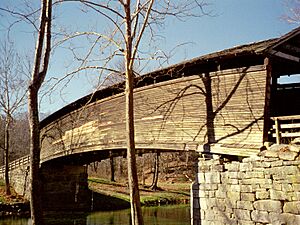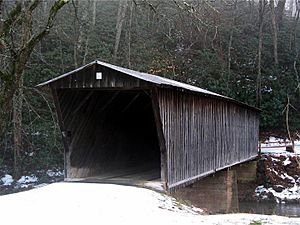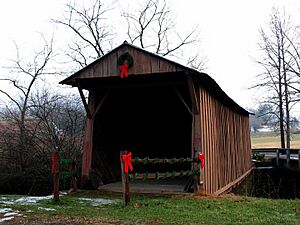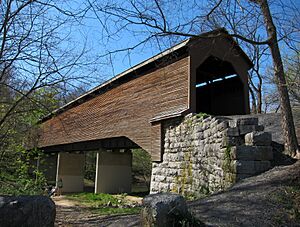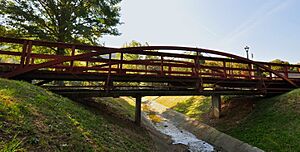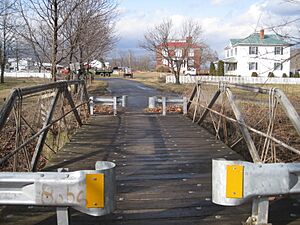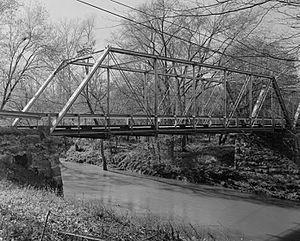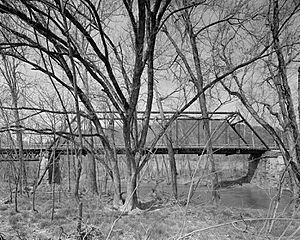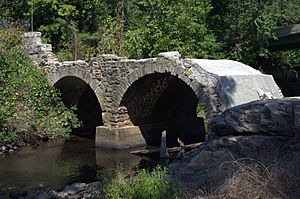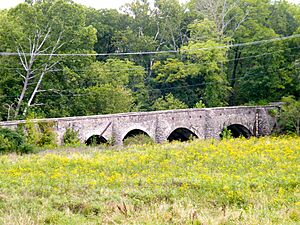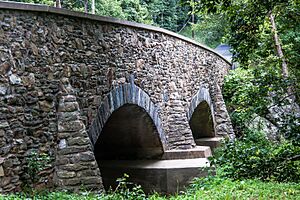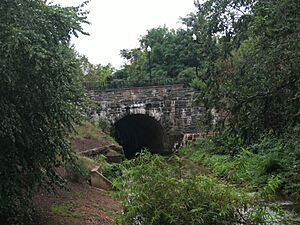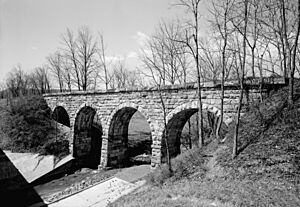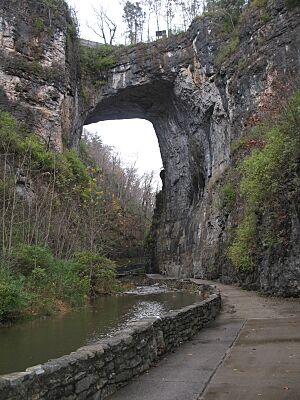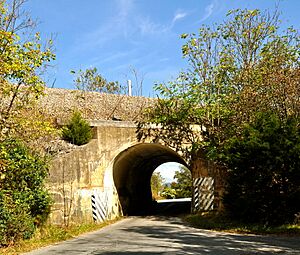List of bridges on the National Register of Historic Places in Virginia
Virginia is home to many amazing old bridges and tunnels. Some of these are so special that they are listed on the National Register of Historic Places. This is like a special list of important buildings, places, and structures in the United States that are worth protecting because of their history or unique design.
These bridges and tunnels tell stories about how people traveled and built things long ago. They show us clever ways engineers and builders solved problems, often using materials like wood, stone, and iron. Let's explore some of these cool historic crossings in Virginia!
Contents
What Makes a Bridge Historic?
A bridge or tunnel gets on the National Register of Historic Places if it's really old, has a special design, or played an important part in history. For example, some bridges were key for moving goods or people, while others show off amazing building techniques from the past.
Covered Bridges: Wooden Wonders
Imagine a bridge with a roof and walls! These are called covered bridges. They were built this way to protect the wooden parts of the bridge from rain and snow. This helped the bridges last much longer. Virginia has a few beautiful covered bridges on the historic register.
Humpback Covered Bridge
One of the most famous is the Humpback Covered Bridge near Callaghan. It was built way back in 1835. What makes it unique is its "humpback" shape, which means it curves upwards in the middle. This design helped it handle heavy loads and floods. It's one of the oldest covered bridges still standing in Virginia!
Bob White Covered Bridge
Another charming example is the Bob White Covered Bridge in Woolwine. This bridge was built even earlier, around 1820 or 1821. It uses a special design called a Burr arch truss, which combines strong wooden arches with a crisscross pattern of beams to make it super sturdy.
Jack's Creek Covered Bridge
Also in Woolwine is the Jack's Creek Covered Bridge, built in 1914. It's a bit newer than the Bob White bridge but still shows off the classic covered bridge style.
Meems Bottom Covered Bridge
Near Mt. Jackson, you'll find the Meems Bottom Covered Bridge. It was built in 1893 or 1894 and also uses the strong Burr arch truss design. It's a great example of how these bridges were built to last.
Truss Bridges: Strong and Sturdy
Many historic bridges are "truss" bridges. A truss is a framework of connected triangles. This shape is very strong and efficient for supporting weight. Different types of truss designs have names like Pratt truss or Whipple truss.
Bowstring Truss Bridge
The Bowstring Truss Bridge in Ironto was built in 1878. It has a distinctive curved top chord, like a bow, which gives it its name. This design was popular for its strength and elegant look.
Crab Run Lane Truss Bridge
In McDowell, the Crab Run Lane Truss Bridge from 1896 is another example of a strong truss bridge. These bridges were vital for connecting communities and allowing trade and travel.
Gholson Bridge
The Gholson Bridge, built in 1884, spans the Meherrin River near Lawrenceville. It's a Pratt truss bridge, a common and effective design for its time.
Phoenix Bridge
Near Eagle Rock, the Phoenix Bridge from 1887 is a great example of a Trapezoidal Whipple truss. This type of truss was known for its strength and was often used for railway bridges.
Stone Arch Bridges: Built to Last
Stone arch bridges are some of the oldest and most beautiful bridges. They use the natural strength of an arch to support weight, making them incredibly durable.
Bridge at Falling Creek
The Bridge at Falling Creek near Richmond has parts that date back to around 1823! It's a stone arch bridge, showing how long these structures can last. While parts of it have collapsed over time, its history is still very important.
Goose Creek Stone Bridge
The Goose Creek Stone Bridge near Atoka was built in 1810. Imagine how many people and wagons have crossed this bridge over more than 200 years! It's a testament to the skill of early builders.
Hibbs Bridge
Another historic stone arch bridge is the Hibbs Bridge near Mountville, built in 1829. These bridges are not just ways to cross water; they are works of art and engineering.
Orange and Alexandria Railroad Hooff's Run Bridge
In Alexandria, the Orange and Alexandria Railroad Hooff's Run Bridge is a stone-arch railroad bridge. It was built in 1856 and later updated. It shows how important railroads were for transportation in the past.
Valley Railroad Stone Bridge
The Valley Railroad Stone Bridge near Jolivue was built in 1874. This impressive stone structure was part of the railroad system that helped connect different parts of Virginia.
Other Notable Crossings
Virginia has many other interesting historic bridges and even a tunnel.
Natural Bridge
The Natural Bridge is truly unique because it's a natural stone arch, not built by people! It was formed over millions of years by water carving through rock. It's been recognized as a special place since 1774.
Virginian Railway Underpass
The Virginian Railway Underpass in New Ellett is a horseshoe-arch underpass built in 1906. An underpass goes *under* something, like a road or another railway, instead of over it. This one is a great example of early 20th-century railway engineering.
Images for kids


